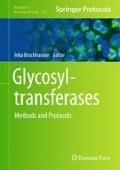Abstract
Detecting and quantifying hyaluronan (HA) made by Class I HA synthase (HAS) and determining the level of activity of these membrane-bound enzymes is critical in studies to understand the normal biology of HA and how changes in HAS activity and HA levels or size are important in inflammatory and other diseases, tumorigenesis, and metastasis. Unlike the products made by the vast majority of glycosyltransferases, HA products are more complicated since they are made as a heterogeneous population of sizes spanning a broad mass range. Three radioactive and nonradioactive assay methods are described that can give the amount of HA made with or without information about the distribution of product sizes.
Access this chapter
Tax calculation will be finalised at checkout
Purchases are for personal use only
References
Fosang AJ, Hey NJ, Carney SL, Hardingham TE (1990) An ELISA plate based assay for hyaluronan using biotinylated proteoglycan G1 domain (HA-binding region). Matrix 10:306–313
Itano N, Sawai T, Yoshida M, Lenas P, Yamada Y, Imagawa M, Shinomura T, Hamaguchi M, Yoshida Y, Ohnuki Y, Miyauchi S, Spicer AP, McDonald JA, Kimata K (1999) Three isoforms of mammalian hyaluronan synthases have distinct enzymatic properties. J Biol Chem 274:25085–25092
Brinck J, Heldin P (1999) Expression of recombinant hyaluronan synthase (HAS) isoforms in CHO cells reduces cell migration and cell surface CD44. Exp Cell Res 252:342–351
Itano N, Kimata K (2002) Mammalian hyaluronan synthases. IUBMB Life 54:195–199
Spicer AP (2001) In vitro assays for hyaluronan synthase. Methods Mol Biol 171:373–382
Weigel PH (2002) Functional characteristics and catalytic mechanisms of the bacterial hyaluronan synthases. IUBMB Life 54:201–210
Tlapak-Simmons VL, Baggenstoss BA, Clyne T, Weigel PH (1999) Purification and lipid dependence of the recombinant hyaluronan synthases from Streptococcus pyogenes and Streptococcus equisimilis. J Biol Chem 274:4239–4245
Yoshida M, Itano N, Yamada Y, Kimata K (2000) In vitro synthesis of hyaluronan by a single protein derived from mouse HAS1 gene and characterization of amino acid residues essential for the activity. J Biol Chem 275:497–506
DeAngelis PL, Oatman LC, Gay DF (2003) Rapid chemoenzymatic synthesis of monodisperse hyaluronan oligosaccharides with immobilized enzyme reactors. J Biol Chem 278:35199–35203
Weigel PH, DeAngelis PL (2007) Hyaluronan synthases: a decade-plus of novel glycosyltransferases. J Biol Chem 282:36777–36781
Prehm P (1983) Synthesis of hyaluronate in differentiated teratocarcinoma cells. Characterization of the synthase. Biochem J 211:181–189
Sheehan JK, Arundel C, Phelps CF (1983) Effect of the cations sodium, potassium, and calcium on the interactions of hyaluronate chains: a light scattering and viscometric study. Int J Biol Macromol 5:222–228
Lee HG, Cowman MK (1994) An agarose gel electrophoretic method for analysis of hyaluronan molecular weight distribution. Anal Biochem 219:278–287
Prehm P (1983) Synthesis of hyaluronate in differentiated teratocarcinoma cells. Mechanism of chain growth. Biochem J 211:191–198
Wyatt PJ (1997) Multiangle light scattering combined with HPLC. LCGC 15:160–168
Wyatt PJ (1993) Light scattering and the absolute characterization of macromolecules. Anal Chim Acta 272:1–40
Tlapak-Simmons VL, Kempner ES, Baggenstoss BA, Weigel PH (1998) The active streptococcal hyaluronan synthases (HASs) contain a single HAS monomer and multiple cardiolipin molecules. J Biol Chem 273:26100–26109
Pettaway CA, Pathak S, Greene G, Ramirez E, Wilson MR, Killion JJ, Fidler IJ (1996) Selection of highly metastatic variants of different human prostatic carcinomas using orthotopic implantation in nude mice. Clin Cancer Res 2:1627–1636
Kumari K, Tlapak-Simmons VL, Baggenstoss BA, Weigel PH (2002) The streptococcal hyaluronan synthases are inhibited by sulfhydryl modifying reagents but conserved cysteine residues are not essential for enzyme function. J Biol Chem 277:13943–13951
Tlapak-Simmons VL, Baggenstoss BA, Kumari K, Heldermon C, Weigel PH (1999) Kinetic characterization of the recombinant hyaluronan synthases from Streptococcus pyogenes and Streptococcus equisimilis. J Biol Chem 274:4246–4253
Folch J, Lees M, Sloane Stanley GH (1957) A simple method for the isolation and purification of total lipides from animal tissues. J Biol Chem 226:497–509
Ghosh S, Khobal I, Zanette D, Reed WF (1993) Conformational contraction and hydrolysis of hyaluronate in sodium hydroxide solutions. Macromolecules 26:4684–4691
Tlapak-Simmons VL, Baron CA, Weigel PH (2004) Characterization of the purified hyaluronan synthase from Streptococcus equisimilis. Biochemistry 43:9234–9242
Baggenstoss BA, Weigel PH (2006) Size exclusion chromatography-multiangle laser light scattering analysis of hyaluronan size distributions made by membrane-bound hyaluronan synthase. Anal Biochem 352:243–251
Author information
Authors and Affiliations
Editor information
Editors and Affiliations
Rights and permissions
Copyright information
© 2013 Springer Science+Business Media New York
About this protocol
Cite this protocol
Weigel, P.H., Padgett-McCue, A.J., Baggenstoss, B.A. (2013). Methods for Measuring Class I Membrane-Bound Hyaluronan Synthase Activity. In: Brockhausen, I. (eds) Glycosyltransferases. Methods in Molecular Biology, vol 1022. Humana Press, Totowa, NJ. https://doi.org/10.1007/978-1-62703-465-4_18
Download citation
DOI: https://doi.org/10.1007/978-1-62703-465-4_18
Published:
Publisher Name: Humana Press, Totowa, NJ
Print ISBN: 978-1-62703-464-7
Online ISBN: 978-1-62703-465-4
eBook Packages: Springer Protocols

